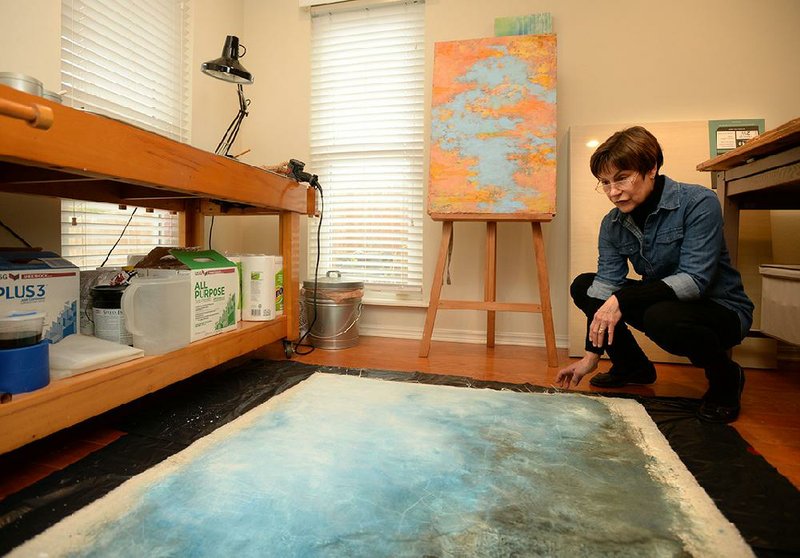A nonprofit that creates affordable living and work spaces for artists plans to seek sites and funding sources for a project in Little Rock or North Little Rock.
The results of a market study presented last week show a hunger for a shared creative space that people in those areas can afford, officials from the nonprofit Artspace said.
"We're very committed to figuring out how to make Little Rock work," said Wendy Holmes, senior vice president of consulting and strategic partnerships for the Minneapolis-based nonprofit that has developed living and working spaces for artists in more than 50 locations across the country.
The nonprofit first arrived in Central Arkansas in July to see if either city would be a good spot to develop housing and work spaces for low-income artists. The study, representatives from Artspace said, shows that the need and market exist.
Holmes said that last week marked her fifth trip to the area, and it wouldn't be her last.
The organization's next steps will be identifying funding sources and possible sites in the cities. The nonprofit plans to seek funding from the state in the form of Low Income Housing Tax Credits. Holmes said using a historic building would allow the project to take advantage of additional tax credit opportunities.
Artspace doesn't undertake a project in every city it studies.
Kathleen Kvern, senior vice president of national advancement for Artspace, said the nonprofit conducts about 20 studies a year but takes on just two to five projects annually.
Holmes said each of the organization's projects is unique, though a space in Little Rock would likely be a mixed-use development, with businesses and arts organizations on the first floor and apartments for artists above.
Those first-floor tenants could include art supply stores, creative services and spaces for entrepreneurs, as well as a coffee shop, she said.
The artists' apartments would be live-work spaces, which Holmes said are slightly larger than typical apartments, with high ceilings, durable surfaces and open floor plans.
STILL LOOKING
Kvern said Wednesday that it was too early to name any possible sites in Little Rock or North Little Rock.
Holmes said the demand for creative space was large enough that she encouraged private developers to capitalize on it
The study was funded by the Windgate Foundation, a Little Rock-based nonprofit focused on art and education. A group of officials from local arts and economic development institutions -- including the Arkansas Community Foundation, the Little Rock Regional Chamber of Commerce, the Arkansas Arts Center, the Arkansas Arts Council and the University of Arkansas at Little Rock -- coordinated focus groups and outreach for the study over the past several months.
Of the 825 people who responded to the survey, 799 identified themselves as "creatives," or people involved in arts, cultural or creative work or practices. Of the creatives, 683, or 85%, were interested in space, and 200, or 25% were interested in relocating to affordable live-work housing for artists.
Nearly 60%, or 453 creatives, were interested in renting shared creative space, and 30%, or 241, were interested in private studio space.
The top neighborhoods of interest for such a space were downtown Little Rock and the city's South Main neighborhood, as well as the Argenta district in North Little Rock. Respondents also named Little Rock's East Village, the UALR area and the Dunbar neighborhood in Little Rock.
Three of every five of the respondents were from Little Rock, a city of nearly 200,000, and 13% were from North Little Rock, a city of about 65,000.
Respondents' artistic disciplines included painting; drawing; arts education and instruction; mixed media; writing and literary arts; and crafts. More than 60% of the respondents were female, and 81% were white.
Teri Deaver, vice president of consulting and strategic partnerships for Artspace, said the organizers did not see as much racial and ethnic diversity as they would have liked, and plan to do more outreach. She said the results are just a snapshot that they hope to make more representative of the area's population.
Crystal Mercer, a local poet, performance artist and social justice activist who helped organize the study, said she was focused on including artists from myriad disciplines, particularly those who are "young, black, brown and queer," in Artspace's efforts.
Mercer explained the value of a space where artists can focus on their work free from distractions from children and schoolwork, and free from the fear of discrimination, eviction and displacement, which she said is happening in places that are becoming gentrified.
"I hope there is a building in Little Rock," she said. "I hope there's a space in Little Rock that artists have access to where they can breathe."
SURVEY RESULTS IN
Artspace representatives and Central Arkansas officials said they found the number of responses exciting. A larger number of people responded to the survey than the number that completed surveys in Denver and Austin, Texas, said Mary Kennedy, director and curator at the Windgate Museum of Art at Hendrix College in Conway.
"We're really pleased. We had a huge response," said Patrick Ralston, director of the Arkansas Arts Council. "For an area of this size, you hope that you're going to get a couple of hundred."
Ralston said the response gives the results of the survey "a lot of weight."
"My takeaway is that the need is here," he said. "Artists are being priced out of the very communities that they enrich."
Excitement over the possibility of a new space for artists culminated in an event at the Mosaic Templars Cultural Center on Wednesday, when the nonprofit's team released the market study's results. Music from the Trap Jazz Giants filled the upstairs room as guests mingled.
"I feel like it was a small opportunity to really make a difference in my hometown," said Kelly Fleming, director of development for the Arkansas Arts Center. "When you see the possibilities you just get really excited about what this could mean."
Christina Shutt, director of the Mosaic Templars center, said Artspace could be a valuable partner in the center's mission of preserving and interpreting black history.
Little Rock Mayor Frank Scott Jr., who spoke at Wednesday's event, said the nexus of arts, education and the economy is "a recipe for success for any city that's trying to become a trendsetter."
"I'm ready to go all in on Artspace," the mayor said.
Artspace is already exploring another project in the state in Bentonville. That project is in the conceptual stage.
Separate from that project is The Momentary, a contemporary art space in Bentonville that includes space for artists-in-residence, as well as a black box theater, an indoor multidisciplinary performance space and gathering areas. The Momentary is to open Feb. 22, spokeswoman Emily Neuman said in an email.
Metro on 02/02/2020

